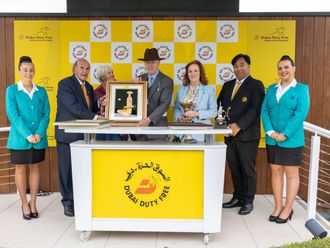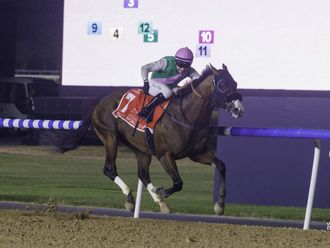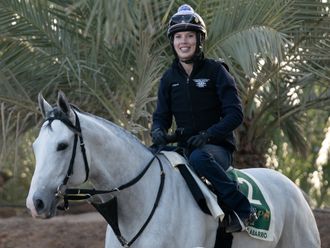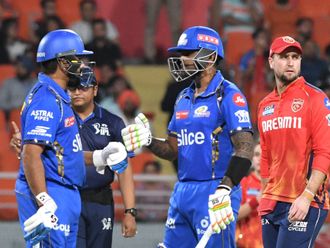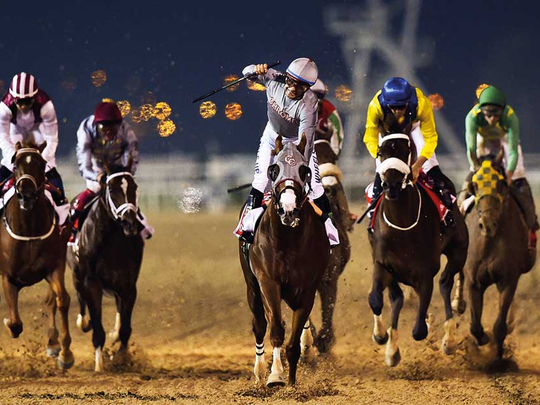
Princess Haya Bint Al Hussain |
People who buy racehorses are investing in a dream.
The goal is tantalisingly simple. Each and every Thoroughbred owner hopes that their horse will have the talent to string together a series of big race wins. The prize money will represent an excellent return on their investment, and the thrill of watching their horse chalk up successive wins is the added bonus.
The owners of horses that will line up in the headline races at the Dubai World Cup meeting will already, to varying degrees, have fulfilled this dream for their owners.
But like in any sport, for every headline-grabbing performer on the track, there are hundreds of horses who never make it to racing’s top tier. They are, in many respects, the backbone of the racing industry, filling the majority of race fields around the world.
It is not just about the big-ticket races such as the Dubai World Cup. In the UAE and at our showpiece venue at Meydan, there are races to suit every level of horse, from first-time runners to those at the top of the sport.
The dream for racehorse owners is to find that special horse, with a mix of athleticism, determination and durability that can make it to the top.
This is not a fanciful dream. The history of racing is full of accounts of horses, who have risen from humble beginnings to score major track victories.
So, how does a racehorse owner seek out such a horse? The process is much the same everywhere. Most will rely on the expertise of the person who will train their horse or an agent to find one that suits their requirements.
Considerable store is put on a horse’s pedigree. In Thoroughbreds, breeding lines can be traced back 300 years to the birth of the breed and the three founding desert stallions — The Darley Arabian, The Byerley Turk, and The Godolphin Arabian — who contributed so much to its foundation stock.
The earlier pedigrees of these stallions, from the late 1600s to early 1700s are lost in time, but all registered racehorses today trace their lineage to one — or sometimes all — of the three.
Naturally, buyers of bloodstock focus on the recent generations, looking to the success of closely related progeny and the quality of the horse’s parents. As one man once said: “Breed to the best and hope for the best”.
Results suggest that the best way to breed a winner is from a very good race mare. In a catalogue at sales, the catalogue will have the names of big race winners in a bold font. So you will often hear racing people say, the mare has a lot of black type, which means she has many winners in her background.
That aside, there are many breeding theories, some which follow the crossing of certain lines together, others using a mare line, while others may choose to select on the performance of close relations.
However, part of the magic of racing is that breeding is not everything. A top athlete can just be a freak of nature.
Good breeding improves the chances of success, but the best-bred horse in the world could still prove to be an average track performer — or not even make it to the racetrack. Conversely, young horses with an unremarkable pedigree, who may have cost their owner only a few hundred dollars, can rise to be champions. It is the same in other horse sports — the humblest of horses can triumph.
So it is not simply a matter of breeding the best to the best — there are many other factors to consider. There are even genetic tests that predict what race distances are likely to best suit a horse.
But experienced horsemen often prefer to use their eye and gut feeling when assessing a horse for its racing possibilities.
Horses destined for race careers are generally sold as one-year-olds, called yearlings. Older horses are sometimes offered at ready-to-race sales, while others change hands several times through their racing careers.
It is not hard to imagine the challenges in picking potential winners at just one year of age. Buyers will consider the quality of their breeding, but will look to other important clues, including the body type and shape. Special attention will be paid to their legs and hooves, as horses with even minor issues may not stand up to training.
The way the youngster carries himself is important, how he stands and moves, and those with an experienced eye will be looking for clues to the horse’s temperament and its likelihood of standing up to the mental rigours of training and racing.
Horsemen will generally look for a horse that moves well and is well balanced.
The most important attribute of a racehorse is speed, of course, but that can only be the subject of a well-educated assessment before a horse enters training, and it may even take a season or two and several races for a horse to show its true ability.
Racehorse ownership is not for the impatient. Some horses may fail to perform under the care of one trainer, yet prosper under another. A horse may thrive with one method of training, but become sour with another. It may come down to the location of the training facility, its surroundings, the track surface, or even the staff of the trainer.
There are three main racing surfaces throughout the world — grass, dirt, and synthetic. Some horses will go better on one surface than another, and there is the added complication of the condition of the track itself.
Underfoot conditions can vary. A horse may run better on a hard surface, while another may like some “give” in the ground. Good horseman will also bear in mind that some horses have feet better suited to one surface or the other, almost like running shoes either suited for grass or dirt.
There are so many factors that go into a winning performance, which is why the sport is the ultimate challenge for a horseman — and the racehorse.


